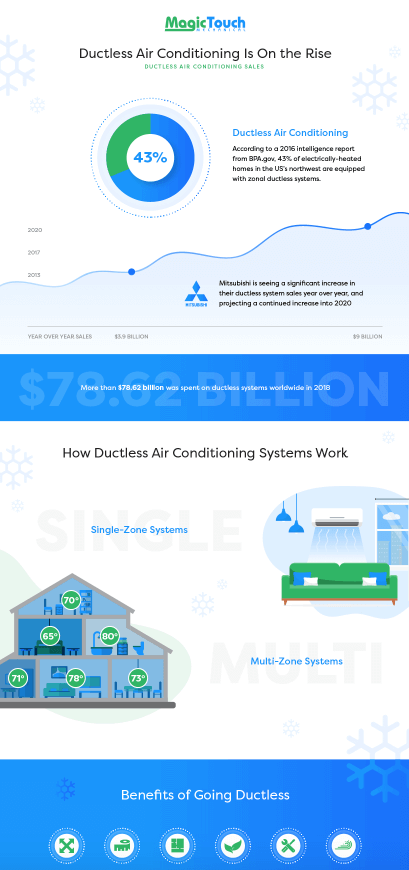Guide to Ductless Air Conditioning: Infographic
One of the fastest-growing developments in air conditioning technology is ductless systems. Since they were introduced in Japan in the 1970’s, ductless air conditioning systems have slowly spread around the world, allowing zone-specific temperatures and eliminating the need for duct installation. Why have these systems become so popular, and how can you determine whether a ductless air conditioner is right for your home? Read on to learn all about it:
The Growing Popularity of Ductless Air Conditioning Systems
You are likely to see ductless systems when you travel to Asia, Europe, Central America, or the Middle East. Many homes and businesses in these regions were built before the invention of central air conditioning systems. Renovating these properties for an A/C system is costly. Conversely, installation of a ductless system is quick and relatively affordable. Moreover, ductless systems are more reliable, more energy efficient, and much quieter than central A/C systems. That’s why ductless air conditioning systems are skyrocketing in popularity here in the U.S.
In the United States, about 34% of single-family homes, and 2% of manufactured homes were were potential prime candidates for new ductless system installation as of 2016. According to the same report from BPA.gov, 43% of electrically-heated homes in the northwest region of the United States were already equipped with ductless systems. That number is increasing as ductless systems are becoming more and more popular. Mitsubishi, one of the leading brands in ductless air conditioning systems, recorded $3.9 billion in sales in 2013 (about 14% of all their heating-cooling sales). The company is expecting (and has already experienced) a significant increase in ductless sales over the next decade years. Sales are on course to reach more than $9 billion by 2020 (about 30% of all projected heating-cooling sales). The same trend is seen by ductless system manufacturers and installation experts around the world. In fact, more than$78.62 billion was spent on ductless systems in 2018.

Components in a Ductless Air Conditioning System
Each ductless A/C system is comprised of three primary parts:
- Outdoor Condenser Unit
- Indoor Air Handling Unit(s)
- Refrigerant Coolant Lines
Single-Zone Systems
Single-Zone Systems are relatively easy to install in most applications. The installation of the condenser unit, air handling unit, and refrigerant lines is usually very straightforward and quick to complete. These systems are ideal for use when you are building an addition to the home, or converting a garage or basement space into a functional living area.
Multi-Zone Systems
Multi-Zone Systems allow you to cool multiple areas of your home. This requires connecting a single compressor to two or more indoor units. A single compressor has enough capacity for up to eight indoor units which allows you to create up to eight zones within your home. Creating zones within the home gives you significant control over your comfort. It allows you to keep your bedrooms, kitchen, living room, etc. at precisely the temperature you desire. In addition to greater control over your comfort, it provides enhanced ability to control your monthly energy usage.
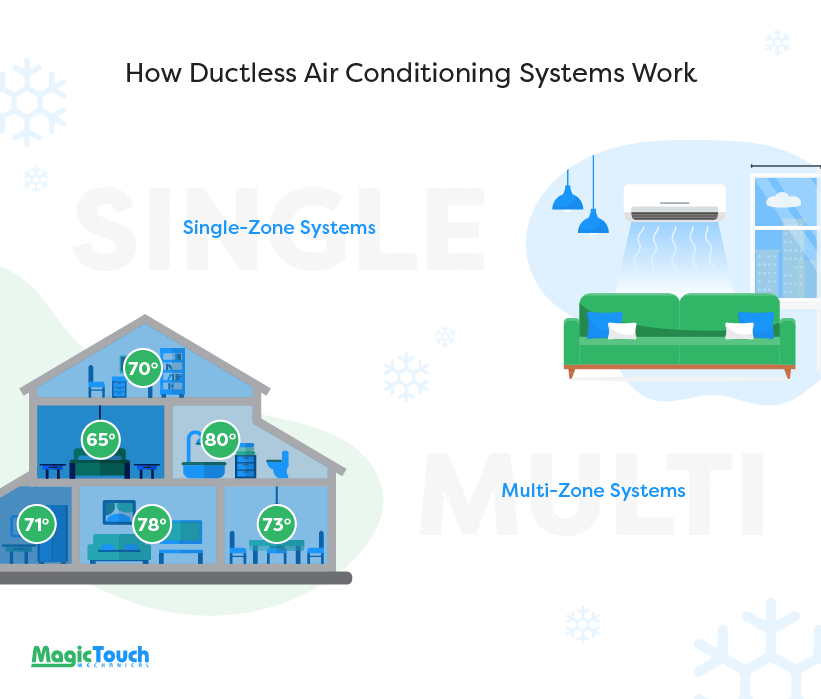
Advantages of Ductless Systems
Ductless systems offer numerous advantages. These include:
- More useable space: The absence of a duct means that you won’t lose efficiency. You will enjoy the same cooling comfort without bleeding up to 30% of your cool air into attics, crawlspaces, and between the walls.
- Adaptable design: Installation flexibility makes it easy to incorporate your ductless system into your interior design. Most systems are less than 7-9 inches wide. This makes it possible to blend the unit into the room so that it is not intrusive or obvious.
- Zoned comfort: Ductless systems make it easy to zone your home and control each zone with its own thermostat. This allows you to create customized comfort for every room, and everyone, in the home.
- Eco-friendly cooling: Most ductless systems use R410A refrigerant. This ozone safe refrigerant means that you can cool your home without having a significant impact on the environment.
- Easy installation: Installation is a breeze in many older homes. Often, you can install a ductless system in an older home without having to conduct major renovations or remodel the entire home.
- Cleaner air: Because there are no ducts to collect dust, pollen, and other micro particles, you won’t have these circulating throughout your home. Improved indoor air quality is a significant benefit for anyone who suffers from allergies, COPD, or other breathing difficulties.

Mounting Options
There are four common mounting options for the indoor unit of your ductless air conditioning system.
- Wall Mount – These are quick and easy to install, which also makes them the least costly option. These are typically placed near the ceiling and the vanes within the unit blow air down into the room below.
- Floor (Low-Wall) Mount – Floor mounted units are as easy to install as wall mounted systems, and similarly, they blow air up into the room. It’s important to know that because they are located near the floor, these units require frequent cleanings and must be protected from foot traffic.
- Ceiling Mount – The indoor unit can be recessed into the ceiling. Known as a cassette unit, these are ideal for large, open rooms such as living rooms, kitchens, dining rooms, etc. These units require roughly 10 inches of space above the ceiling for mounting. Once installed, they send air down into the room from all four sides of the cassette. Smaller cassettes known as 1-way cassettes are growing in popularity and can be used in smaller rooms and bedrooms as well.
- Hidden Mount – Hidden, or concealed systems are positioned within the soffit or ceiling. These are connected to hidden ducts that circulate cool air into the room. This gives you a cool breeze without the conspicuous presence of the cooling unit.
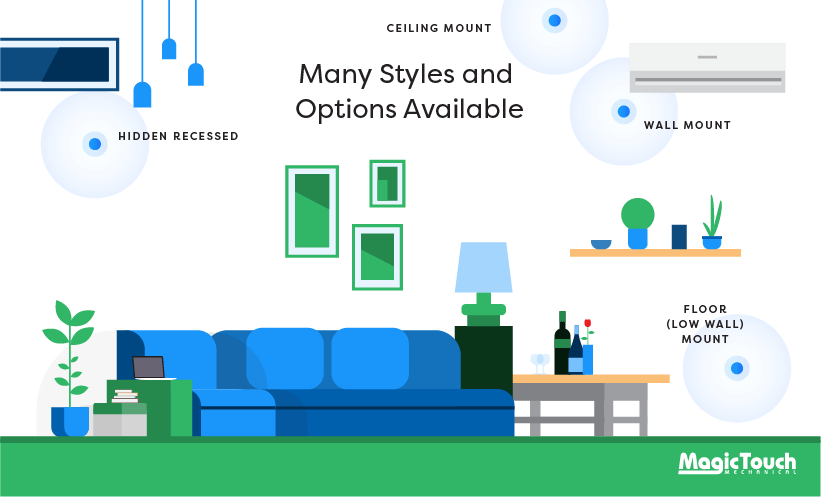
How Much Does it Cost to Install Ductless Air Conditioning?
Single-zone systems typically cost between $6,000 – $8,000. The cost of the system is influenced by the brand, efficiency rating, type of air handler, labor, and other materials required to complete the installation.
Multi-zone systems can cost anywhere from $6,800 – $12,000 for 2 to 3 zones. This cost can increase up to $30,000 for up to 8 zones. This is because each installation is customized to fit the design of the home and the specific needs of the homeowner.
Ductless systems can shave 30-40% or more off your monthly electricity bills. In Arizona, that easily adds up to $500 or more per year.
Remember, size and SEER rating matter when it comes to how much you can save. SEER ratings for new ductless systems range from 14 to 30+; the higher the rating, the greater the energy efficiency and savings.

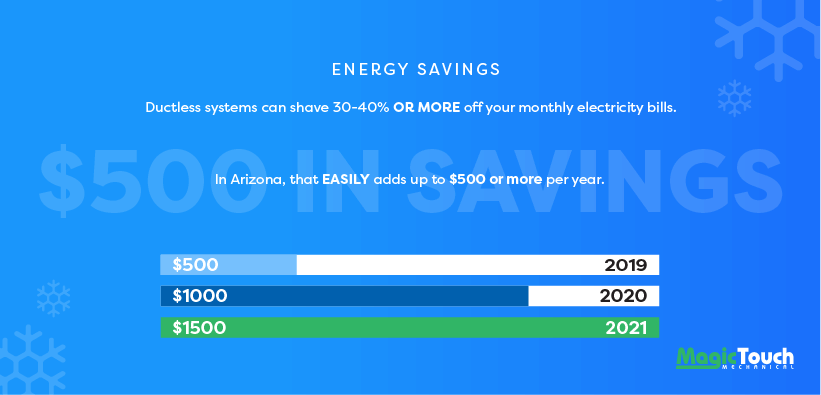
Choosing the Right Sized Unit
Ductless systems range in size from 6,000 BTU all the way up to 36,000 BTU. Choosing the right size is crucial to achieving maximum savings. If you’re searching for online ballpark figures, you’ll seldom find numbers that actually match your specific situation. Calculating needed BTU’s based solely on area isn’t adequate. The only proper way to determine the size air conditioning & heating system needed for any space is by conducting a load calculation, also called a heat gain/loss analysis. There are numerous factors beyond square footage that influence your air conditioning needs, such as geography, climate, shading, window position, insulation, exterior landscaping, etc. These all need to be considered to determine the appropriately sized ductless air conditioning system for your home. Before giving you a personal suggestion for your home, we’ll conduct an ACCA Certified Manual-J Load Calculation that will carefully gauge the factors that can affect your air conditioning needs.
Create More Functional Space With Ductless A/C
Could you use an extra room? Very often, we see clients installing ductless air conditioning in a small area of their home, in order to make an area that would be otherwise unlivable into a functional, comfortable area. For example, you can install ductless air conditioning in your garage in order to transform it into a home theater. Ductless air conditioning allows you to get effective temperature control in a new space without making changes to, or taxing your existing central air conditioning system.
Transform your…
- Garage
- Attic
- Basement
- Enclosed Porch
- Pool House
Into a…
- Home office
- Gym
- Playroom
- Workshop
- Art studio
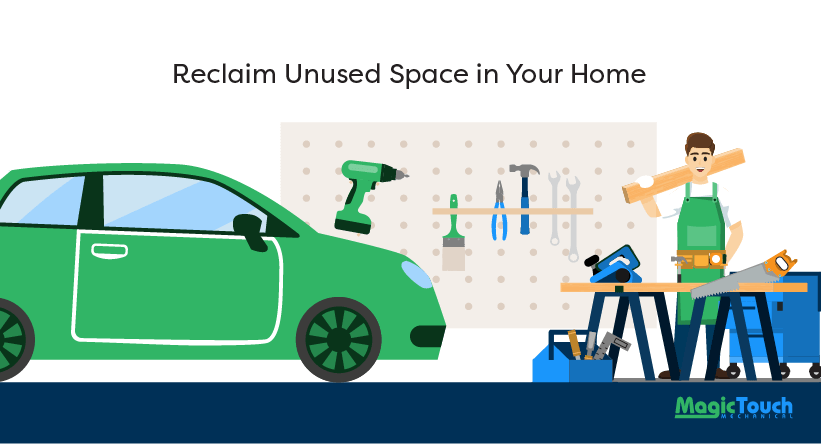
Call Magic Touch Mechanical to Learn More
Here at Magic Touch Mechanical, we’re passionate about providing comprehensive cooling solutions and connecting our customers with the right system for their needs. We’ve installed thousands of units throughout Phoenix and the surrounding communities, and we understand the unique cooling demands of the area. We’ve seen for ourselves how ductless units are gaining popularity throughout the Valley of the Sun. Furthermore, we’ve seen why!
Are you considering installing a new air conditioning for your home? Give us a call today for a home energy audit that will help you determine which unit will be the best for you.
Hot Deals Available Now Exclusively From Magic Touch Mechanical
Download the Full Infographic Below:
